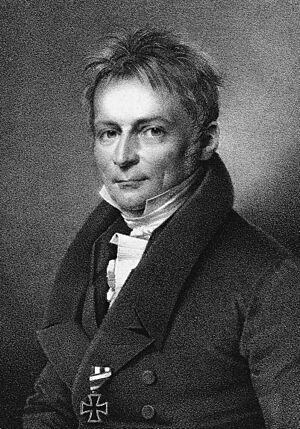Henrik Steffens facts for kids
Quick facts for kids
Henrik Steffens
|
|
|---|---|

Lithograph of Steffens by Franz Krüger, 1828
|
|
| Born | 2 May 1773 |
| Died | 13 February 1845 (aged 71) |
| Scientific career | |
| Fields | Philosophy, Geology, Mineralogy |
Henrik Steffens (born May 2, 1773 – died February 13, 1845) was a famous Norwegian philosopher, scientist, and poet. He helped bring new ideas, especially German Romanticism, to Denmark. He also worked to connect science with these new ways of thinking about nature.
Contents
Early Life and Learning Adventures
Henrik Steffens was born in Stavanger, Norway. When he was 14, he moved with his family to Copenhagen, Denmark. There, he studied theology (the study of religion) and natural science.
In 1796, he started giving lectures at the University of Kiel. Two years later, he went to the University of Jena to learn about the natural philosophy of Friedrich Schelling. This was a way of thinking that tried to understand nature through philosophy.
Exploring Earth's Secrets
In 1800, Steffens traveled to Freiberg. Here, he was influenced by Abraham Gottlob Werner, a well-known geologist. In 1801, Steffens published an important book on geology called Beiträge zur inneren Naturgeschichte der Erde (which means Contributions to the Inner Natural History of the Earth). This book became his most successful scientific work.
In his book, he supported the Neptunist theory. This idea suggested that all rocks, including those that form mountains, were created from water. This was different from the Vulcanist theory, which said that rocks were formed by heat and volcanoes. Another student in Freiberg, Alexander von Humboldt, later supported the Vulcanist idea.
Bringing New Ideas to Denmark
After two years, Steffens returned to Copenhagen. In 1802, he gave nine lectures at Elers Kollegium. These talks are famous for introducing German romanticism to Denmark. Romanticism was a movement that focused on emotion, nature, and individual experience.
These lectures were very popular and inspired many future Danish thinkers. People like Oehlenschläger and Grundtvig attended them. Even the famous philosopher Friedrich Schleiermacher was impressed. He tried to get Steffens a teaching job at the new Berlin University in 1804, but it didn't work out.
Teaching and New Theories
Even though his lectures were very impactful, Steffens wasn't fully welcomed by the Danish authorities. So, he moved back to Germany. In 1804, he became a professor at the University of Halle. He only visited Denmark occasionally after that.
During the Battle of Leipzig in 1813, he joined the Prussian Army. He was even present when Paris was captured the next year. From 1811 to 1832, he was a physics professor at Breslau. Then, he accepted an invitation to teach in Berlin.
Understanding Nature's Design
Steffens was one of the "Philosophers of Nature." He was a friend and follower of Schelling and Schleiermacher. He knew a lot about new scientific discoveries. This helped him improve or change some of Schelling's imaginative ideas.
Steffens believed that a key idea in nature and life was individualisation. This means that as living things become more developed, their unique features become clearer. He tried to show this idea using his knowledge of geology. His ideas were very important, and both Schelling and Schleiermacher changed their own theories based on his scientific findings.
Some of his important scientific and philosophical books include:
- Beiträge zur inneren Naturgeschichte der Erde (1801)
- Grundzuge der philosophischen Naturwissenschaft (1806)
- Anthropologie (1824)
In his last five years, he wrote his autobiography, Was ich erlebte (What I Experienced). After he passed away, his Nachgelassene Schriften (Published Writings) were released in 1846.
Henrik Steffens' Lasting Impact
Henrik Steffens was a very important person in the history of Romanticism in Scandinavia. He was a leading figure in trying to combine the new natural sciences with Romantic ideas about nature. For a while in the 20th century, his ideas were not as popular because science focused more on facts and observations.
However, with the rise of the Anthropocene (a new way of thinking about how humans affect the Earth), Steffens' ideas have been rediscovered. People are now finding inspiration in his work for understanding how different fields, like ecology and earth sciences, can work together.
The Henrik Steffens Professorship
There is a special teaching position called the Henrik Steffens Professor at the Humboldt University of Berlin. This position focuses on humanities (like history and literature) and social sciences (like sociology). The Government of Norway provides money for this professorship. It is managed by both Humboldt University and the University of Oslo.
This professorship was created in 1998, after a visit by German President Roman Herzog to Norway. The idea came from Lucy Caroline Smith, who was the Rector of the University of Oslo. The main goal of this professorship is to encourage academic teamwork between Norway and Germany in the humanities and social sciences, "in the spirit of Henrik Steffens." It is one of nine special professorships at Humboldt University.
The professorship is based at the Department of Northern European Studies at Humboldt University. This department is located near Unter den Linden, a famous street in Berlin.

